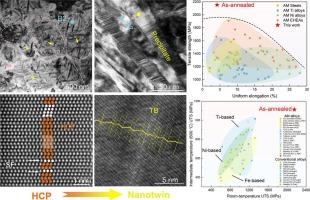纳米孪晶析出相通过增材制造诱导出了超高共晶高熵合金
IF 22
1区 材料科学
Q1 MATERIALS SCIENCE, MULTIDISCIPLINARY
引用次数: 0
摘要
调制二次相是提高金属材料力学性能的关键途径,在很大程度上依赖于加工方法和合金成分。在这里,我们利用激光粉末床熔融的极端打印条件,在AlCoCrFeNi2.1共晶高熵合金(EHEA)中创建了以B2相为主的非平衡微观结构。简单的后热处理将高密度的纳米沉淀物(具有超细平行双片层(~ 2.4 nm))引入B2基体。这些纳米孪晶(NT)沉淀,在传统加工的HEAs中是前所未有的,通过一个有趣的两步过程形成,包括通过肖克利部分位错的滑移将六边形紧密堆积转变为NT结构。成功地将纳米孪晶加入到析出相中,与构建样品相比,在不影响延展性的情况下,获得了565 MPa的显著强化。在室温下得到的抗拉强度达到2200 MPa,标志着增材制造HEAs的最高强度之一。这一突破为制造具有独特微结构和优异性能的结构材料铺平了道路,具有广泛的应用前景。本文章由计算机程序翻译,如有差异,请以英文原文为准。

Nanotwinned precipitates induced ultra-strong AlCoCrFeNi2.1 eutectic high-entropy alloy through additive manufacturing
Modulating the secondary phase is a key approach to enhancing the mechanical properties of metallic materials, relying heavily on processing methods and alloy composition. Here, we harness the extreme printing conditions of laser-based powder bed fusion to create a non-equilibrium microstructure dominated by the B2 phase in an AlCoCrFeNi2.1 eutectic high-entropy alloy (EHEA). A simple post-heat treatment introduces high-density nanoprecipitates, featuring ultrafine parallel twin lamellae (∼2.4 nm), into the B2 matrix. These nanotwinned (NT) precipitates, unprecedented in traditionally processed HEAs, form via an intriguing two-step process, involving the transformation of the hexagonal close-packed into an NT structure through the slipping of Shockley partial dislocations. The successful incorporation of nanotwin into precipitates delivers remarkable strengthening of 565 MPa without compromising ductility compared to the as-built sample. The resulting tensile strength reaches 2200 MPa at room temperature, marking one of the highest strengths reported for additively manufactured HEAs. This breakthrough paves the way to fabricate structural materials with unique microstructures and excellent properties for broad applications.
求助全文
通过发布文献求助,成功后即可免费获取论文全文。
去求助
来源期刊

Materials Today
工程技术-材料科学:综合
CiteScore
36.30
自引率
1.20%
发文量
237
审稿时长
23 days
期刊介绍:
Materials Today is the leading journal in the Materials Today family, focusing on the latest and most impactful work in the materials science community. With a reputation for excellence in news and reviews, the journal has now expanded its coverage to include original research and aims to be at the forefront of the field.
We welcome comprehensive articles, short communications, and review articles from established leaders in the rapidly evolving fields of materials science and related disciplines. We strive to provide authors with rigorous peer review, fast publication, and maximum exposure for their work. While we only accept the most significant manuscripts, our speedy evaluation process ensures that there are no unnecessary publication delays.
 求助内容:
求助内容: 应助结果提醒方式:
应助结果提醒方式:


